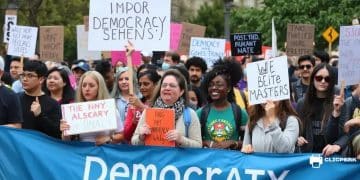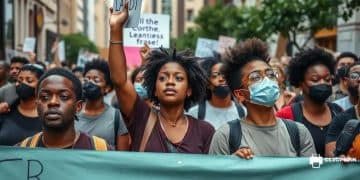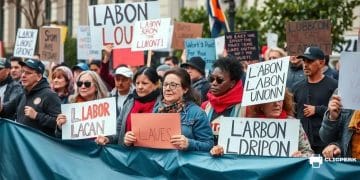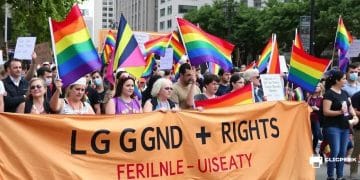Constitutional rights protests: what you need to know
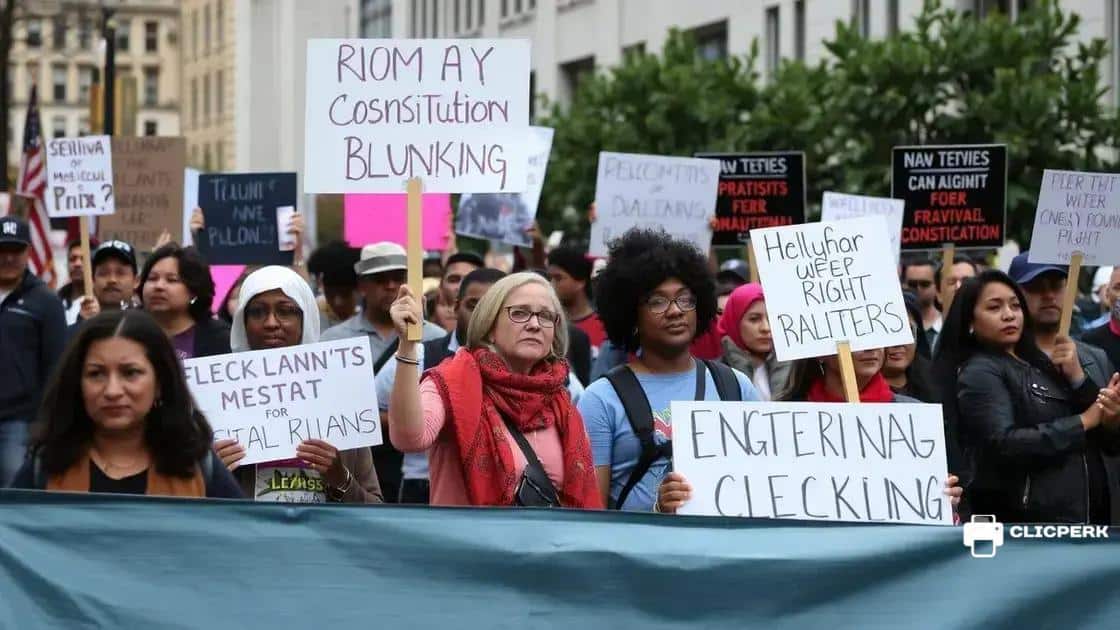
Constitutional rights protests are critical movements that advocate for social justice and civil liberties, addressing issues like racial equality, women’s rights, and systemic injustice through collective action and community engagement.
Constitutional rights protests play a crucial role in advocating for democracy and social justice. But have you ever wondered what motivates these movements? This article dives into their significance and impact.
Understanding the history of constitutional rights protests
Understanding the history of constitutional rights protests is essential to grasp their importance today. These protests have evolved over decades, addressing various social issues. From civil rights movements to modern-day advocacy, they have served as a powerful tool for change.
The origins of constitutional rights movements
The roots of these protests can be traced back to significant historical events. Many were inspired by the civil rights movement in the 1960s, aiming to end racial segregation. Other movements sought to expand rights for women, LGBTQ+ individuals, and marginalized communities.
Key milestones in protest history
Several milestones have shaped the landscape of constitutional rights protests:
- The March on Washington in 1963, where Dr. Martin Luther King Jr. delivered his famous “I Have a Dream” speech.
- The Stonewall Riots of 1969, which galvanized the LGBTQ+ rights movement.
- The Women’s March in 2017, which highlighted issues of gender equality and reproductive rights.
Throughout the years, these protests have drawn attention to injustices and pushed for reforms in laws and policies. They have also inspired countless individuals to join the fight for justice and equality.
The role of grassroots organizations cannot be understated. Many protests began at the local level, driven by community leaders and passionate citizens. Over time, these efforts grew, often catching the attention of the national media and government. This coverage has been vital in raising awareness about various causes.
As we reflect on the history, we see a continuous line of advocacy that connects past movements to current events. Protests today still draw inspiration from those who fought for constitutional rights in the past, often using similar tactics, such as peaceful demonstrations and social media campaigns.
Understanding this history enriches our appreciation for the ongoing struggles for rights and freedoms. It’s a reminder that progress requires effort and persistence.
Key issues driving modern protests
Many key issues driving modern protests reflect the urgent need for change in our society. Understanding these issues helps us see why people take to the streets. Each protest addresses specific concerns that resonate with large groups of people.
Systemic Racism
One major issue is systemic racism. Protests often focus on police violence against racial minorities. Activists demand accountability and justice to combat discrimination and inequality.
Climate Change
Another pressing concern is climate change. Many activists rally for policies that protect the environment. They encourage government action to reduce emissions and promote sustainable practices.
- Demand for renewable energy solutions
- Advocating for reduced carbon footprints
- Promoting transparency in environmental policies
Additionally, economic inequality is a prevalent theme. People are expressing frustration over wealth disparity. The gap between the rich and the poor is growing, leading to social unrest.
Healthcare access is also a crucial topic. Protests often call for affordable healthcare for all. Many believe that basic health services should be a right, not a privilege.
Finally, reproductive rights are a foundational issue for many protesters. This includes advocating for women’s rights to make choices about their bodies. Activists are fighting against restrictive laws that limit access to reproductive healthcare.
These issues are interconnected, often leading people to unite over common goals. The modern protest landscape is shaped by these significant concerns, pushing for a more just and equitable society.
The role of social media in mobilizing activists
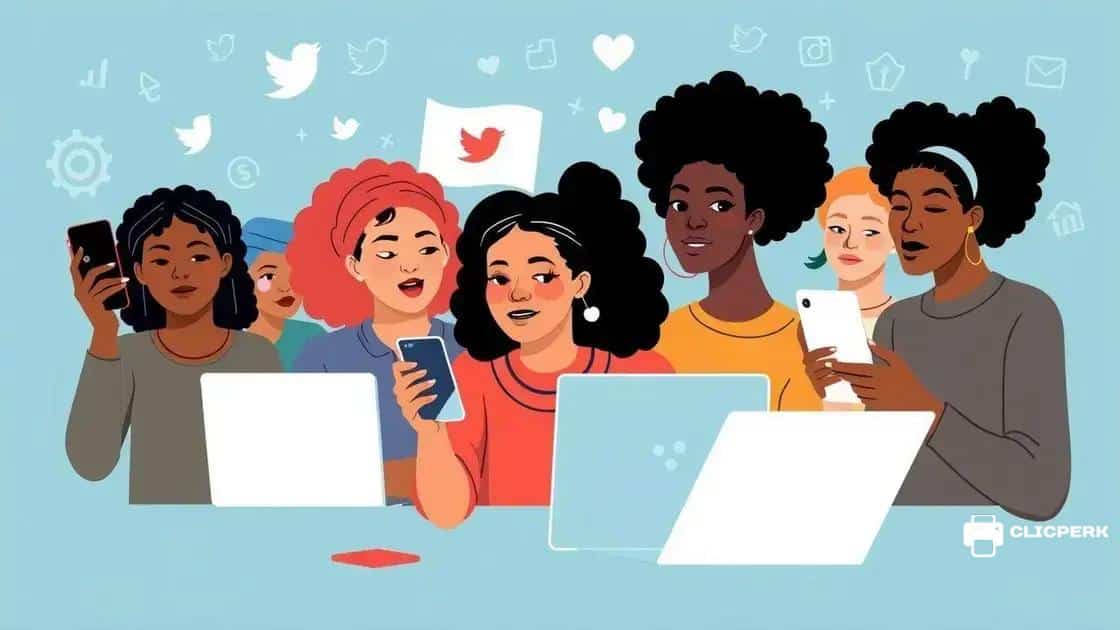
The role of social media in mobilizing activists today cannot be underestimated. Platforms like Twitter, Facebook, and Instagram have changed how movements organize and communicate. Activists use these tools to spread messages quickly and connect with people who share their values.
Real-time communication
One significant advantage of social media is the ability to communicate in real time. Information about protests or important events can be shared instantly, reaching a broad audience. This speed allows activists to rally support quickly. For example, hashtags can become rallying cries, uniting people under a single cause.
Building communities
Social media also helps activists build communities. Online groups allow like-minded individuals to share ideas and strategies. This sense of community provides support and encouragement, which is vital for sustaining movements.
- Engaging conversations around key issues
- Sharing resources and information
- Encouraging local and global participation
Moreover, social media campaigns can raise awareness about critical issues. Viral posts can bring attention to injustices that might otherwise go unnoticed. Visual content like videos and images engages audiences, making issues more relatable and urgent.
Another important aspect is fundraising. Social media platforms allow activists to create campaigns for financial support. This funding can help cover costs for organizing protests, creating materials, and reaching more people. Crowdfunding has become a powerful tool for many movements.
While there are challenges, such as misinformation and online harassment, the overall impact of social media on activism has been transformative. It provides tools for organization, communication, and outreach, driving movements forward in ways that were not possible before.
Legal implications of attending protests
Understanding the legal implications of attending protests is crucial for participants. There are rights and responsibilities for those who choose to engage in peaceful demonstrations. Knowing these can help ensure safety and legal protection during such events.
Your rights as a protester
In many countries, including the United States, the First Amendment protects the right to assemble peacefully. This means people can gather to express their views without fear of government retaliation. However, there are guidelines to follow.
- Individuals should understand local laws regarding permits for large gatherings.
- Know the boundaries of free speech, especially regarding hate speech or threats.
- Be aware of any restrictions on the designated protest area.
Even when protests are peaceful, police may intervene. Understanding your rights during interactions with law enforcement is vital. Protesters can film encounters, request identification, and ask for an attorney if detained.
Potential legal challenges
While many protests remain nonviolent, some may result in confrontations. Participants should recognize potential legal consequences. Charges such as disorderly conduct or trespassing may arise if laws are broken.
Legal support is often available for activists. Organizations focusing on civil rights may offer resources, including legal advice or representation. It’s advisable for protesters to stay informed and, if possible, carry contact information for legal aid.
Understanding the legal landscape helps create a safer environment for all involved. Knowledge empowers activists to advocate confidently, knowing their rights and obligations while participating in protests.
Case studies of impactful constitutional rights protests
Case studies of impactful constitutional rights protests reveal how activism shapes society. These protests often highlight urgent issues and can lead to significant change. Learning from past movements helps us understand the power of collective action.
The Civil Rights Movement
The Civil Rights Movement in the 1960s is a prime example. Activists fought against racial segregation and discrimination. The March on Washington in 1963 was pivotal, where Dr. Martin Luther King Jr. delivered his iconic “I Have a Dream” speech. This event galvanized support for civil rights legislation and inspired people worldwide.
The Women’s March
An impactful recent example is the Women’s March of 2017. Millions gathered across the globe to advocate for women’s rights and equality. The unity displayed at these marches sent a powerful message about the importance of women’s voices in the political arena.
- Highlighted issues like reproductive rights and workplace equality.
- Created a network of activists focusing on various social justice issues.
- Encouraged political engagement among women and allies.
Another notable case is the Black Lives Matter (BLM) movement. Sparked by the tragic events following the death of George Floyd in 2020, protests erupted across the United States and beyond. BLM highlights systemic racism and police brutality, urging society to reflect on these critical issues.
This movement has successfully pushed for police reform and accountability measures in various cities. The use of social media helped amplify the message, connecting activists and supporters rapidly.
These case studies illustrate that constitutional rights protests can create lasting changes. They challenge societal norms and push for legislation that fosters equality and justice. By studying these impactful protests, we can learn how to advocate for change effectively.
constitutional rights protests is vital for anyone interested in social change. These movements have shaped history, highlighting important issues like racial justice, women’s rights, and equality. By studying case studies and learning from the past, we strengthen our ability to advocate for a better future. Social media and community support are crucial for mobilizing efforts and raising awareness. Together, we can continue to champion rights and encourage meaningful dialogue in our society.

